Seven A / B tests, without which not a single good email newsletter can do
When it comes to optimizing the conversion, we usually start with the top of the funnel - the time of posting in social networks, the wording of the call to action, the choice of headings and images on landing pages.
But as soon as we understand how to benefit from the above variables, it is the turn to look at the bottom lines of the funnel.
Why? It's simple. People who have stepped forward to meet you, subscribing to your newsletter or a free trial version of the product - this is a valuable audience, receptive to your messages. And a series of timely and well-written emails can be a powerful tool in the way of turning a loyal user into a regular customer.
A / B testing is a powerful optimization tool that should not be limited to the subject of the letter. This article contains seven advanced A / B tests that will ensure maximum conversion from email distribution.
')
A new user has just signed up for the 14-day free version of the product. Now you and your letters have two weeks to inspire and convince him to pay for the full version. So how many letters do you need for this?
One per day? It looks like annoying spam, isn't it?
One per week? For a week, the user will probably forget that he received something from you before.
Or maybe you should send five letters on the first day? Or three letters in three days, and then none during the week?
There may be many variations of such questions, but one thing unites them all - you will not feel a happy medium unless you turn to A / B testing.
The question of the number and frequency of distribution should not arise from scratch. Of course, you can send a lot of emails at once, and it is possible that the conversion will rise at the same time, but this effect will be temporary, will not bring you useful information, will not provide a better understanding of the user's behavior.
One of the options for a conscious search is to immerse in hypothetical reflections, implicated in the knowledge of the product and the user's needs, which are often referred to as the search for insight:
INSITE: People who subscribe to the free version of the product are trying to solve an urgent problem. Very urgent, the first in the list of urgent matters. They will intensively research your service and competitors' products for the next 48 hours, and will try to use them for the first time within 72 hours.
HYPOTHESIS: Sending welcome letters for the first 72 hours will be appropriate, timely and important for such users, and is likely to increase conversion.
The course of thought is transparent, insight seems to be true, you can test.
Modeling consumption situations based on understanding the needs of your consumers will help you understand when and how often letters should be sent. In addition, such reflections are interesting to develop, moving towards understanding other aspects of email marketing and creating the groundwork for new hypotheses, and, accordingly, tests and experiments.
In this article , Michael Agaard reflects on how to build hypotheses based on insights. His examples relate to landing pages, but the process is universal for all cases. Do not try to guess how many letters you need to properly greet and addict the user to your newsletter. Test, and let the opinion of the users themselves win.
First of all, we tested the time and frequency of mailing, now let's deal with the content. We are not talking about the title of the letter or the call to action, because we all know how to do it .
Instead, let's take a look at the tactics that many companies use to increase conversion: creating a sense of urgency. By specifying tight deadlines or mentioning a limited quantity of goods in stock, you can make the user want to hurry with the decision to act right now.
How Doggyloot uses urgency
The Doggyloot store sent letters to users who added products to the cart, but in fact did not order anything. In the letters containing a link to the “stockless to the cash register” basket, it was stated that “the goods you added to the basket are almost sold out.”
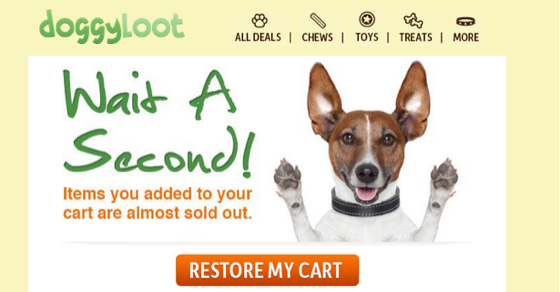
What is left is little interest. Image source .
Reception is working - these letters monthly generate income equal to the daily vyorgu shop . Therefore, every time I optimize an automated newsletter, I start with experiments with urgency. Most often they provide the greatest instant effect.
If you are not sure where to start testing, start by sending reminders at different time intervals.
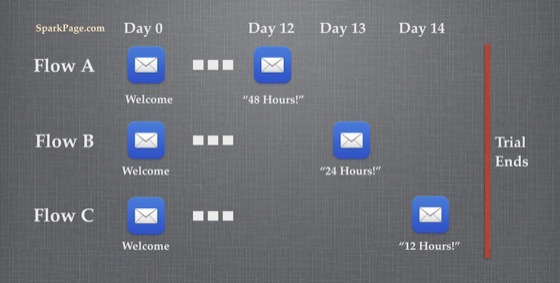
Try sending emails about the end of the trial period at intervals of 48, 24 and 12 hours.
A couple of things to remember:
Doggyloot mailings were also effective because local marketers understood that dogs arebiting different, that is, literally big and small, and have conducted user segmentation tests according to the size of their pets.
This is quite logical, because the owner of a chihuahua is unlikely to buy her Coco meter dog gum, intended for breeds such as St. Bernard, because then the food will be the size of a dog.
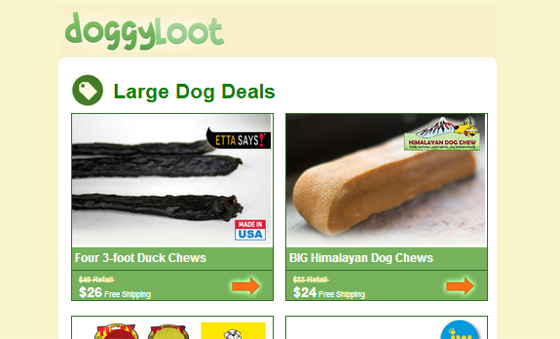
Almost a meter-long dog gum is unlikely to suit a chihuahua. Image source .
Such a segmentation of the client base gave an amazing result. Letters targeted at owners of large dogs increased clicks on advertising by 410% .
Now the first question that Doggyloot asks new users is: “What size is your dog?”
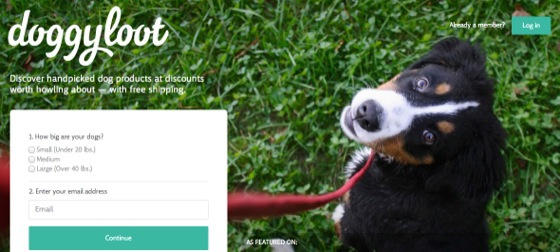
The form on the left asks “What size is your dog?”
Knowing and using only one, but important details about users can seriously affect the conversion of your mailings.
What other personal data can be used in experiments with personalization?
All of the above is fertile soil for testing, it is important to just start.
In early 2012, I read this post by Derek Halpern, after which I wrote one of my most successful letters.
In this article, Derek recommends attracting new users or subscribers to a blog with one simple question: “What problem are you trying to solve?”
Since the article was first published, I have used this technique again and again, and I realized that this is an excellent question.
Existing customers are carriers of extremely valuable information about your company. In my SaaS company , the answers to the question “What do you spend most of your working day on, what problem are you trying to solve?”
Groove , the company offering software for technical support, has included similar questions in the newsletter for new users:
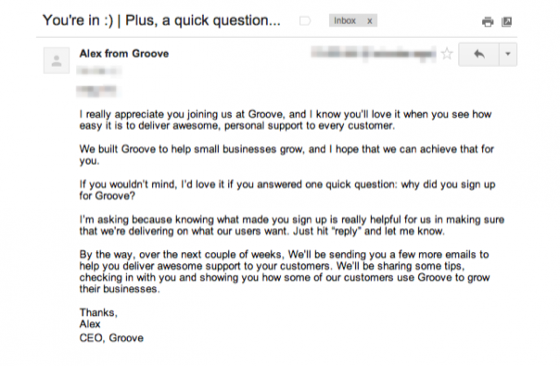
“Why did you subscribe to Groove?” Image source .
Groove admitted that “this newsletter provided 41% more responses and presented us with our clients' business and place of our service in it much more than any other.”
Here are some of the answers they received:

The feedback received by Groove helped to improve the content of the mailings and landing pages. Image source .
Using the information gained through feedback, Groove improved its marketing messages and, ultimately, doubled the conversion from the home page.
Also, they made an interesting observation about the timing of the response to such mailings:
“It is curious how the answers change between two categories of users: those who respond to the letter immediately after registration, and those who have already managed to use the service for at least a week. In the second case, the essence of the letter shifts towards the discussion of specific functions and applications. ”
The question of feedback in mailings is very important and able to give a lot of useful information, but take the trouble to find out (test) when and what to ask your users - then the benefits of it will be even greater.
When I was involved in marketing consulting, I had many clients among musicians and record companies. Some of them had huge databases for sending out a monthly news digest.
In general, these mailings showed a good result, but there was one problem: you subscribed to it for 10 days or 10 years, you still received the same content. Most of the subscribers were not newcomers, respectively, the information in the mailing list, addressed primarily to experienced fans, often discouraged those who have just subscribed.
Then we created newsletters for new customers, leaving the main newsletters for experienced customers intact, and the result was not long in coming.
Instead of a stream of news, new subscribers received a series of letters in which they were presented with a musician, told about him, building an emotional connection. And only a few weeks later the new subscriber was offered to support the artist by purchasing his album.

With one Irish performer, we tested a variety of factors that could influence the purchase decision when we offered it. If we decide to send a letter a day or two before asking for a purchase, what exactly will stimulate the user and increase the conversion? Maybe something social, for example, information about the number of users who have already bought the album? Or a reminder that by buying an album, you support the artist you like, helping him to create more good music?
It turned out that the greatest effect (doubling sales) was capable of bringing an unexpected gift.
After four weeks of subscription, the user received an email with several free tracks and a personalized greeting from the musician.

It was just a gift that didn’t require anything from the user, and that was what made him so successful. As a result, the people who received the gift were twice as willing to buy an album or t-shirt, when in a couple of days they were offered this.
This technique is appropriate in any business. For example, I know that some companies, pursuing similar goals, sent out free e-books or provided access to a webinar.
Psychologists can tell in more detail how this works (gifts generate a desire to do something in return). In any case, practice shows that an unexpected pleasant gift from the company enhances the user's mood, and he is more likely to buy her product or service in the future.
So, we talked a little about content as such and its impact on mailing efficiency, but what about its design?
Should your welcome letter strike with colors and design? Or is it better to make it restrained by applying in it only a couple of dies from the brand book, a logo and a picture of the goods? Or maybe it is better to use letters without any design or design?
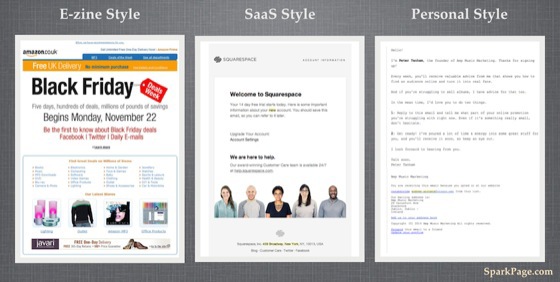
As you probably guessed, the only way to decide is to test different options.
The Obama campaign team in 2012 found that personalized letters containing a “clean” text give the best effect.
This is what Amelia Sawalter, head of analytics for Obama’s campaign headquarters, said: “I think this solution looked like improvisation, it seemed that the letters were written by real people, that they were not painfully born during different focus groups.”
On the other hand, the company Wishpond writes about completely opposite test results in his blog. They found an article stating that “high-quality, detailed images are 67% more powerful for users than product descriptions and reviews from other people,” and decided to check this statement on their newsletters. And, interestingly, in the end, they found that letters with images receive 60% more clicks than those that contain only “bare” text.
I bring here these cases to demonstrate: in this matter it is difficult to trust your intuition, industry standards or the example of competitors. You just need to conduct tests.
What happens when the free trial of your product ends? What to do if you sent timely, informative and targeted letters to new subscribers, but they never bought anything?
The fact that the user is inactive now does not mean that he is not interested in your product. It is reasonable to try to remind him of yourself.
Let's take a look at two letters that Squarespace sends to those who have not continued using its product after the trial version has ended.
The first letter arriving two days after the end of the free subscription offers to renew it for another week - a good combination of “urgency” and the possibility of returning the client.
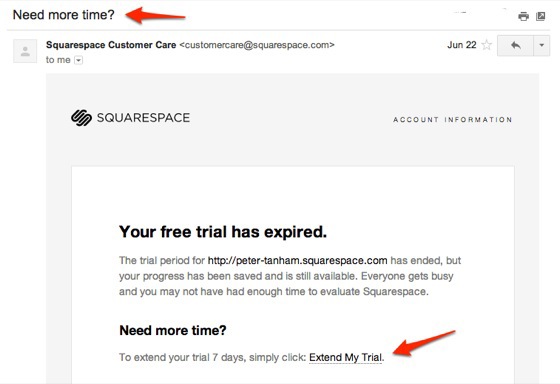
The second letter, which comes another couple of days later, is entitled “What can we improve?”
Although formally this letter asking for feedback, it still gives the user the opportunity to extend the free subscription and leaves a “window” for a possible purchase in the future.
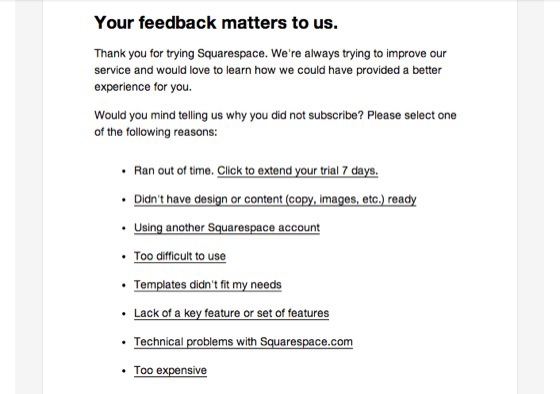
Groove also offers a free period of use, and if a customer doesn’t buy anything, they remind themselves of themselves 7, 21 and 90 days after the expiration of the free period.
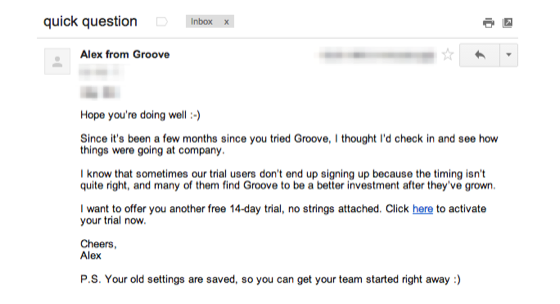
A period of 90 days may seem too long (does the user remember about the service at all?), But testing has shown a stable conversion of 2% of such letters.
Of course, this figure is not amazing, but agree that 2% is better than 0%.
The point is not to copy a well-known successful tactic. You need to be inspired and conduct tests mailings, achieving the optimal effect in your case. You will need some information about the recipients - you can get it by researching existing mailings or simply asking users what tasks they are solving or would like to solve using your product or service.
By connecting several well-made landing pages in conjunction with correctly composed letters, you will receive an increase in conversion and loyalty of existing users. But the only way to achieve this is to constantly test your posts. For such tasks there are many services, including those with a free trial period, for example, Mailchimp , AWeber or SparkPage .
Test, test and test again, achieve the perfect result in a real dialogue with the user!
_______________________________
This is a translation of the article by Peter Tanhem, Irish expert in mobile marketing, analytics and optimization, the creator of the service https://www.sparkpage.com/ .
But as soon as we understand how to benefit from the above variables, it is the turn to look at the bottom lines of the funnel.
Why? It's simple. People who have stepped forward to meet you, subscribing to your newsletter or a free trial version of the product - this is a valuable audience, receptive to your messages. And a series of timely and well-written emails can be a powerful tool in the way of turning a loyal user into a regular customer.
A / B testing is a powerful optimization tool that should not be limited to the subject of the letter. This article contains seven advanced A / B tests that will ensure maximum conversion from email distribution.
')
Testing timing and mailing frequency
A new user has just signed up for the 14-day free version of the product. Now you and your letters have two weeks to inspire and convince him to pay for the full version. So how many letters do you need for this?
One per day? It looks like annoying spam, isn't it?
One per week? For a week, the user will probably forget that he received something from you before.
Or maybe you should send five letters on the first day? Or three letters in three days, and then none during the week?
There may be many variations of such questions, but one thing unites them all - you will not feel a happy medium unless you turn to A / B testing.
How to test the frequency
The question of the number and frequency of distribution should not arise from scratch. Of course, you can send a lot of emails at once, and it is possible that the conversion will rise at the same time, but this effect will be temporary, will not bring you useful information, will not provide a better understanding of the user's behavior.
One of the options for a conscious search is to immerse in hypothetical reflections, implicated in the knowledge of the product and the user's needs, which are often referred to as the search for insight:
INSITE: People who subscribe to the free version of the product are trying to solve an urgent problem. Very urgent, the first in the list of urgent matters. They will intensively research your service and competitors' products for the next 48 hours, and will try to use them for the first time within 72 hours.
HYPOTHESIS: Sending welcome letters for the first 72 hours will be appropriate, timely and important for such users, and is likely to increase conversion.
The course of thought is transparent, insight seems to be true, you can test.
Modeling consumption situations based on understanding the needs of your consumers will help you understand when and how often letters should be sent. In addition, such reflections are interesting to develop, moving towards understanding other aspects of email marketing and creating the groundwork for new hypotheses, and, accordingly, tests and experiments.
In this article , Michael Agaard reflects on how to build hypotheses based on insights. His examples relate to landing pages, but the process is universal for all cases. Do not try to guess how many letters you need to properly greet and addict the user to your newsletter. Test, and let the opinion of the users themselves win.
Urgency / Relevance Testing
First of all, we tested the time and frequency of mailing, now let's deal with the content. We are not talking about the title of the letter or the call to action, because we all know how to do it .
Instead, let's take a look at the tactics that many companies use to increase conversion: creating a sense of urgency. By specifying tight deadlines or mentioning a limited quantity of goods in stock, you can make the user want to hurry with the decision to act right now.
How Doggyloot uses urgency
The Doggyloot store sent letters to users who added products to the cart, but in fact did not order anything. In the letters containing a link to the “stockless to the cash register” basket, it was stated that “the goods you added to the basket are almost sold out.”

What is left is little interest. Image source .
Reception is working - these letters monthly generate income equal to the daily vyorgu shop . Therefore, every time I optimize an automated newsletter, I start with experiments with urgency. Most often they provide the greatest instant effect.
How to test urgency
If you are not sure where to start testing, start by sending reminders at different time intervals.

Try sending emails about the end of the trial period at intervals of 48, 24 and 12 hours.
A couple of things to remember:
- Always include in the tests a control group not included in the list. It will serve as a basic “level,” and help you see that any reminder letter, regardless of timing, is always better than no letter. In addition, it will accurately measure the effect of each letter on the conversion rate.
- The number of variants of letters depends on the number of subscribers to the newsletter. If there are few, start with a couple of options. I usually test for two or three weeks and choose from those that provided at least about 100 conversions.
Personalization testing
Doggyloot mailings were also effective because local marketers understood that dogs are
This is quite logical, because the owner of a chihuahua is unlikely to buy her Coco meter dog gum, intended for breeds such as St. Bernard, because then the food will be the size of a dog.

Almost a meter-long dog gum is unlikely to suit a chihuahua. Image source .
Such a segmentation of the client base gave an amazing result. Letters targeted at owners of large dogs increased clicks on advertising by 410% .
Now the first question that Doggyloot asks new users is: “What size is your dog?”

The form on the left asks “What size is your dog?”
Knowing and using only one, but important details about users can seriously affect the conversion of your mailings.
What other personal data can be used in experiments with personalization?
- Start with basic data that you probably have - name, date of birth, company name
- You can work with implicit information — the location, the type of device from which a person comes in, or the level of use of your product (type of subscription)
- Pay attention to the advertising campaign that led users to you, their search queries, landing pages on which they subscribed to the newsletter
All of the above is fertile soil for testing, it is important to just start.
Testing feedback requests
In early 2012, I read this post by Derek Halpern, after which I wrote one of my most successful letters.
In this article, Derek recommends attracting new users or subscribers to a blog with one simple question: “What problem are you trying to solve?”
Since the article was first published, I have used this technique again and again, and I realized that this is an excellent question.
How Groove Requests Feedback
Existing customers are carriers of extremely valuable information about your company. In my SaaS company , the answers to the question “What do you spend most of your working day on, what problem are you trying to solve?”
Groove , the company offering software for technical support, has included similar questions in the newsletter for new users:

“Why did you subscribe to Groove?” Image source .
Groove admitted that “this newsletter provided 41% more responses and presented us with our clients' business and place of our service in it much more than any other.”
Here are some of the answers they received:

The feedback received by Groove helped to improve the content of the mailings and landing pages. Image source .
Using the information gained through feedback, Groove improved its marketing messages and, ultimately, doubled the conversion from the home page.
Also, they made an interesting observation about the timing of the response to such mailings:
“It is curious how the answers change between two categories of users: those who respond to the letter immediately after registration, and those who have already managed to use the service for at least a week. In the second case, the essence of the letter shifts towards the discussion of specific functions and applications. ”
The question of feedback in mailings is very important and able to give a lot of useful information, but take the trouble to find out (test) when and what to ask your users - then the benefits of it will be even greater.
Testing the effect of unexpected gifts
When I was involved in marketing consulting, I had many clients among musicians and record companies. Some of them had huge databases for sending out a monthly news digest.
In general, these mailings showed a good result, but there was one problem: you subscribed to it for 10 days or 10 years, you still received the same content. Most of the subscribers were not newcomers, respectively, the information in the mailing list, addressed primarily to experienced fans, often discouraged those who have just subscribed.
Then we created newsletters for new customers, leaving the main newsletters for experienced customers intact, and the result was not long in coming.
Instead of a stream of news, new subscribers received a series of letters in which they were presented with a musician, told about him, building an emotional connection. And only a few weeks later the new subscriber was offered to support the artist by purchasing his album.

With one Irish performer, we tested a variety of factors that could influence the purchase decision when we offered it. If we decide to send a letter a day or two before asking for a purchase, what exactly will stimulate the user and increase the conversion? Maybe something social, for example, information about the number of users who have already bought the album? Or a reminder that by buying an album, you support the artist you like, helping him to create more good music?
It turned out that the greatest effect (doubling sales) was capable of bringing an unexpected gift.
After four weeks of subscription, the user received an email with several free tracks and a personalized greeting from the musician.

It was just a gift that didn’t require anything from the user, and that was what made him so successful. As a result, the people who received the gift were twice as willing to buy an album or t-shirt, when in a couple of days they were offered this.
This technique is appropriate in any business. For example, I know that some companies, pursuing similar goals, sent out free e-books or provided access to a webinar.
Psychologists can tell in more detail how this works (gifts generate a desire to do something in return). In any case, practice shows that an unexpected pleasant gift from the company enhances the user's mood, and he is more likely to buy her product or service in the future.
Design testing
So, we talked a little about content as such and its impact on mailing efficiency, but what about its design?
Should your welcome letter strike with colors and design? Or is it better to make it restrained by applying in it only a couple of dies from the brand book, a logo and a picture of the goods? Or maybe it is better to use letters without any design or design?

As you probably guessed, the only way to decide is to test different options.
The Obama campaign team in 2012 found that personalized letters containing a “clean” text give the best effect.
This is what Amelia Sawalter, head of analytics for Obama’s campaign headquarters, said: “I think this solution looked like improvisation, it seemed that the letters were written by real people, that they were not painfully born during different focus groups.”
On the other hand, the company Wishpond writes about completely opposite test results in his blog. They found an article stating that “high-quality, detailed images are 67% more powerful for users than product descriptions and reviews from other people,” and decided to check this statement on their newsletters. And, interestingly, in the end, they found that letters with images receive 60% more clicks than those that contain only “bare” text.
I bring here these cases to demonstrate: in this matter it is difficult to trust your intuition, industry standards or the example of competitors. You just need to conduct tests.
Testing user retention measures
What happens when the free trial of your product ends? What to do if you sent timely, informative and targeted letters to new subscribers, but they never bought anything?
The fact that the user is inactive now does not mean that he is not interested in your product. It is reasonable to try to remind him of yourself.
How Squarespace returns users
Let's take a look at two letters that Squarespace sends to those who have not continued using its product after the trial version has ended.
The first letter arriving two days after the end of the free subscription offers to renew it for another week - a good combination of “urgency” and the possibility of returning the client.

The second letter, which comes another couple of days later, is entitled “What can we improve?”
Although formally this letter asking for feedback, it still gives the user the opportunity to extend the free subscription and leaves a “window” for a possible purchase in the future.

How Groove Returns Users
Groove also offers a free period of use, and if a customer doesn’t buy anything, they remind themselves of themselves 7, 21 and 90 days after the expiration of the free period.

A period of 90 days may seem too long (does the user remember about the service at all?), But testing has shown a stable conversion of 2% of such letters.
Of course, this figure is not amazing, but agree that 2% is better than 0%.
Reflect and test
The point is not to copy a well-known successful tactic. You need to be inspired and conduct tests mailings, achieving the optimal effect in your case. You will need some information about the recipients - you can get it by researching existing mailings or simply asking users what tasks they are solving or would like to solve using your product or service.
By connecting several well-made landing pages in conjunction with correctly composed letters, you will receive an increase in conversion and loyalty of existing users. But the only way to achieve this is to constantly test your posts. For such tasks there are many services, including those with a free trial period, for example, Mailchimp , AWeber or SparkPage .
Test, test and test again, achieve the perfect result in a real dialogue with the user!
_______________________________
This is a translation of the article by Peter Tanhem, Irish expert in mobile marketing, analytics and optimization, the creator of the service https://www.sparkpage.com/ .
Source: https://habr.com/ru/post/238115/
All Articles